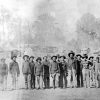calsfoundation@cals.org
Twenty-Second/Thirty-Fifth Arkansas Infantry (CS)
The Twenty-Second/Thirty-Fifth Arkansas Infantry Regiment was a Confederate unit that served in the Trans-Mississippi Theater during the American Civil War. Due to differing numbering system of the Arkansas Military Board and Confederate War Department, it was referred to by both designations at various times.
The regiment was organized on July 11, 1862, near Fort Smith (Sebastian County), composed primarily of men from Benton, Crawford, Franklin, Johnson, Pope, and Sebastian counties. It contained men from the Sixteenth and Seventeenth Arkansas Infantries and Colonel Erasmus Irving Stirman’s First Battalion Arkansas Cavalry who did not accompany those regiments on their transfer to Mississippi. Additional companies were composed of men from the Fifteenth and Fifty-Eighth Arkansas Militias of Johnson and Pope counties seeking to avoid the stigma of conscription. It was originally designated the First Regiment, Northwest Division, Army of the Trans-Mississippi, and referred to as Rector’s War Regiment, First Arkansas Volunteers. Appointed officers were Colonel Frank Rector, Lieutenant Colonel James George, and Major James P. King.
In summer and fall 1862, the regiment trained in northwestern Arkansas before withdrawing south to the Arkansas River near Spadra Bluffs, as Union forces advanced toward northwestern Arkansas. Colonel Rector resigned, being replaced by Major King as the new commander in September 1862, while Henry McCord replaced George James as Lieutenant Colonel on December 3, 1862. Assigned to Brigadier General James Fagan’s Brigade of Brigadier General Francis Shoup’s Division, of Major General Thomas Hindman’s army, it returned north to defend against invading Union forces under Brigadier General James Blunt and Francis Herron. The regiment experienced its first fighting on December 7, 1862, at the Battle of Prairie Grove. In the initial advance by the Federals under Herron, the Thirty-Fifth experienced heavy action along the ridge near the Borden House and into the prairie, where it lost 132 killed and wounded, out of fewer than 500 men. At the close of the battle, Hindman withdrew due to lack of supplies, and the regiment eventually returned to central Arkansas, where it established winter quarters at Little Rock (Pulaski County) and was re-designated as the Thirty-Fifth Arkansas Infantry.
On July 4, 1863, King’s Thirty-Fifth Arkansas participated in the Battle of Helena. Fagan’s brigade was tasked with attacking Battery D, the southernmost of four Union positions along the hills west of the town. Due to confusion in other brigades regarding when to attack, Fagan launched the attack alone at sunrise as ordered. King went forward, following Alexander T. Hawthorne’s Thirty-Ninth and Bell’s Thirty-Seventh Arkansas Infantry and came under immediate fire from Federal artillery in Batteries C and D, and Fort Curtis. As Hawthorne and Bell advanced, King was directed to move to Hawthorne’s right and attack toward Battery D. Fagan’s brigade managed to take five lines of rifle pits as they struggled toward the Union position in extreme heat and over rugged terrain. In this attempt to storm the fortified battery, casualties were extremely high, and the advance faltered. Union forces counterattacked, cutting off many of Hawthorne’s and Bell’s survivors, capturing them en masse. King maintained fire until ordered by Fagan to withdraw. The Confederate forces failed to take the city, eventually retreating back to Little Rock. In the fighting for Battery D, King lost sixteen killed, forty-four wounded, and ninety missing, presumed captured.
For the next month, King’s regiment served at various locations along the White River until Federal forces began their advance on Little Rock. During the initial cavalry battles of August 1863, Confederate infantry, including King’s men, held strong works east of the city and north of the Arkansas River. When Union cavalry successfully forded the Arkansas River below Little Rock on September 10, 1863, the infantry withdrew through Little Rock, retreating to Arkadelphia (Clark County), thus giving up the state capital to the enemy.
While the regiment garrisoned at Camden (Ouachita County), the brigade and regiment underwent leadership changes. Colonel Hawthorne, now promoted to brigadier general, took over as commander of the brigade, which was now assigned to Major General Thomas Churchill’s Arkansas division. Colonel King, on extended sick furlough, was replaced by Lieutenant Colonel McCord in December 1863 as the new commander.
In March 1864, General Nathaniel Banks embarked on his Red River Campaign. Major General Frederick Steele moved south out of Little Rock, hoping to assist Banks in the capture of Trans-Mississippi headquarters at Shreveport, Louisiana, and to threaten Texas. In early April, Hawthorne’s brigade was ordered to Louisiana to assist in the defense against Union forces. Arriving at Shreveport, they were too late to participate in the battles of Pleasant Hill and Mansfield, Louisiana, that forced Banks to retreat. The entire Confederate army then turned north to assist Major General Sterling Price and his cavalry in blocking Steele’s forces coming out of Little Rock.
On April 26, Steele began his retreat toward Little Rock, hoping to escape before the Confederate forces could unite against him. A flooded Saline River blocked Steele until a pontoon bridge could be constructed. Confederates caught up to Steele on April 30, and the resulting Engagement at Jenkins’ Ferry erupted early in the morning. Churchill’s Division arrived first and was ordered to attack immediately. Tappan’s Brigade, as the first wave, was pinned down in a water-filled swale in the middle of a muddy corn field. Hawthorne’s Brigade was ordered forward to assist and also became heavily engaged and stalled in the cornfield. Here, McCord’s troops fought fiercely until heavy Confederate casualties resulted in orders to withdraw. Hawthorne’s report is missing, which leaves exact casualties unknown.
Steele escaped and returned to Little Rock, while Confederate forces remained in southern Arkansas. Previously, the Confederate War Department had designated the regiment as the Twenty-Second Arkansas Infantry, but it was primarily referred to by its Arkansas designation of the Thirty-Fifth. On September 27, 1864, Churchill ordered that McCord’s Twenty-Second/Thirty-Fifth Arkansas be officially designated as the Twenty-Second Arkansas Infantry.
The remnant of the regiment saw no fighting for the remainder of the war and was stationed at various locations across southern Arkansas and northern Louisiana until moving to Marshall, Texas, where General Kirby Smith surrendered the department on May 26, 1865. Ordered to Shreveport, Louisiana to receive their paroles, the regiment did not report, but simply disbanded without formally surrendering. Company B returned to Fort Smith to receive their official paroles, while most of the others individually journeyed to their homes, receiving their paroles at various locations along the way.
For additional information:
Bearss, Edwin C. Steele’s Retreat from Camden and the Battle of Jenkins’ Ferry. Little Rock: Pioneer Press 1967.
Christ, Mark. “The Battle of Helena.” Blue and Gray Magazine 32, no. 4 (October 2016): 58.
Richards, Ira Don. “The Battle of Jenkins’ Ferry.” Arkansas Historical Quarterly 20 (Spring 1961): 3–16.
Shea, William. Fields of Blood: The Prairie Grove Campaign. Chapel Hill: University of North Carolina Press, 2009.
Anthony Rushing
Bryant Public Schools
 Civil War through Reconstruction, 1861 through 1874
Civil War through Reconstruction, 1861 through 1874 Military
Military 22nd/35th Arkansas Infantry (CS) Flag
22nd/35th Arkansas Infantry (CS) Flag 



Comments
No comments on this entry yet.